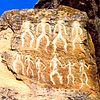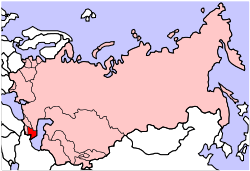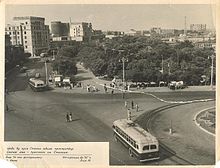- Azerbaijan Soviet Socialist Republic
-
This article is about the former Soviet republic. For other uses, see Azerbaijan (disambiguation).
Azerbaijan Soviet Socialist Republic
Азербайджанская Советская Социалистическая Республика
Азәрбајҹан Совет Сосиалист Республикасы← 
1920–1990  →
→

Flag Coat of arms Anthem
Anthem of Azerbaijan SSRCapital Baku Language(s) Azerbaijani, Russian, and Armenian (in the Nagorno-Karabakh AO) Government Soviet Socialist Republic History - Established 1920 - Disestablished 1990 The Azerbaijan Soviet Socialist Republic (Azerbaijani: Азәрбајҹан Совет Сосиалист Республикасы Azərbaycan Sovet Sosialist Respublikası; Russian: Азербайджанская Советская Социалистическая Республика [АзССР] Azerbaydzhanskaya Sovetskaya Sotsialisticheskaya Respublika [AzSSR]), also known as the Azerbaijan SSR for short, was one of the republics that made up the former Soviet Union.
Established on April 28, 1920 as the Azerbaijan SSR. From March 12, 1922 to December 5, 1936, it was part of the Transcaucasian SFSR together with the Armenian SSR and the Georgian SSR. In December 1922, Transcaucasian SFSR became part of the newly established Soviet Union. The Constitution of Azerbaijan SSR was approved by the 9th Extraordinary All-Azerbaijani Congress of Soviets on March 14, 1937. On November 19, 1990, Azerbaijan SSR was renamed the "Republic of Azerbaijan," remaining in the USSR for another year before its independence in 1991.
Contents
History
Establishment
Main article: Armenian-Azeri war 1918The Azerbaijan SSR was established on April 28, 1920 after the surrender of the government of the Azerbaijan Democratic Republic to local Bolsheviks led by Mirza Davud and Nariman Narimanov and the invasion of the Bolshevik 11th Red Army.
On October 13, 1921, the Soviet republics of Russia, Armenia, Azerbaijan, and Georgia signed an agreement with Turkey known as the Treaty of Kars. The previously independent Naxicivan SSR would also become an autonomous ASSR within Azerbaijan by the Treaty of Kars.
Borders of Azerbaijan and Armenia, like elsewhere in the USSR, were redrawn several times, yet neither side was completely satisfied with the results.
Transcaucasian SFSR
Main article: Transcaucasian SFSROn March 12, 1922, under heavy pressure from Moscow, the leaders of Azerbaijan, Armenian, and Georgian Soviet Socialist Republics established a union known as the Transcaucasian SFSR. This was the first attempt at a union of Soviet republics, preceding the USSR. The Union Council of TSFSR consisted of the representatives of the three republics - Nariman Narimanov (Azerbaijan), Polikarp Mdivani (Georgia), and Aleksandr Fyodorovich Miasnikyan (Armenia). The First Secretary of the Transcaucasian Communist Party was Sergo Ordzhonikidze.
History of Azerbaijan 
This article is part of a seriesAntiquity Ancient history and Roman era Atropatene First Persian Empire
and Alexander's conquestsCaucasian Albania Middle Ages Islamic period Seljuk dynasty Atabegs of Azerbaijan Ilkhanate Qara Qoyunlu Aq Qoyunlu Shirvanshahs Classical history Safavid dynasty Khanates Qajar dynasty Russian Rule Early independence History of the name Azerbaijan Azerbaijan Democratic Republic March Days Soviet Azerbaijan Azerbaijan SSR Black January Modern Azerbaijan Republic of Azerbaijan
Azerbaijan Portal
In December 1922, again under pressure from Moscow, TSFSR agreed to join the union with Russia, Ukraine, and Belarus, thus creating the Union of Soviet Socialist Republics which would last until 1991. The TSFSR, however, did not last long. In December 1936, the Transcaucasian Union was finally dismantled when the leaders in the Union Council found themselves unable to come to agreement over several issues. Azerbaijan, Armenia, and Georgia then became union Republics of the Soviet Union directly.
Economy and development
In the spring of 1921 a general change-over from revkoms and kombeds to Soviets took place. In order to help the Azeri oil industry the Supreme Council of the National Economy decided in the same year to provide it with everything necessary out of turn. The new oilfields, like Ilyich Bay, Qara-Chukhur, Lok-Batan and Kala have been discovered. In 1929 a great kolkhoz movement had developed and Azerbaijan became the second Soviet tea producer after the Georgian SSR for the first time. On March 31, 1931 the oil industry of the Azerbaijan SSR, which supplied over 60% of the total Soviet oil production at the time, was awarded the Order of Lenin. The republic gained the second Order on March 15, 1935 during the observation of its 15th anniversary. At the end of the second five-year plan (1933–1937) Azerbaijan appeared at 3rd place in the Soviet Union by its capital investment size.
Soviet-German War
Main article: Azerbaijan during World War IIIn April, 1940, intelligence flights by the British and French Air Forces passed over the Absheron Peninsula. In the first year of the Soviet-German War, Azerbaijan produced 25,4 million tons of oil - a record for the entire history of its oil industry. Meanwhile Great Britain and France seriously considered the possibility of bombing the Republic's oil fields. By the end of 1941, thousands of Azeris had joined the People's Volunteer Corps. Mobilization affected all spheres of life, particularly the oil industries. A week after fighting began, the oil workers themselves took the initiative to extend their work to 12-hour shifts, with no days off, no holidays, and no vacations until the end of the war. Meanwhile in September 1942 Hitler's generals presented him with a large decorated cake which depicted the Caspian Sea and Baku. Baku then became the primary strategic goal of Hitler's 1942 Fall Blau offensive. This offensive was unsuccessful, however. The German army reached the mountains of the Caucasus, but was at the same time decisively defeated at the Battle of Stalingrad and so forced to retreat from the area, abandoning all hopes for a Reichskommisariat Kaukasus. In 1942 Azerbaijan also became the second largest tea producer of the Soviet Army. By the Decree of the Supreme Soviet of the USSR in February 1942, the commitment of more than 500 workers and employees of the oil industry of Azerbaijan was awarded orders and medals. Of the estimated 700,000-800,000 Azeris who were recruited into the Soviet Army, 400,000 died.
The post-war period
Main article: Azerbaijan People's GovernmentApart from the Oil Rocks, Azerbaijan's first offshore field was opened in the early 50s. An event that greatly impacted Azeris on both sides of the border was the Soviet occupation of Iranian Azerbaijan in the summer of 1941. The Soviet military presence south of the Aras River led to a revival of Pan-Azerbaijani nationalism. During the Soviet occupation a revival of the Azerbaijani literary language, which had largely been supplanted by Persian, was promoted with the help of writers, journalists, and teachers from Soviet Azerbaijan. In November 1945, with Soviet backing, an autonomous "Azerbaijan People's Government" was set up at Tabriz under Jafar Pishevari, the leader of the Azerbaijani Democratic Party. Secular cultural institutions and education in Azerbaijani blossomed throughout Iranian Azerbaijan, and speculation grew rife about a possible unification of the two Azerbaijan's, under Soviet control. As it turned out, the issue of Iranian Azerbaijan became one of the first conflicts of the Cold War, and under pressure by the Western powers, the Soviet army was withdrawn. The Iranian government regained control over Iranian Azerbaijan by the end of 1946 and Democratic Party leaders took refuge in Soviet Azerbaijan. Jafar Pishevari, who was never fully trusted by Stalin, soon died under mysterious circumstances.
Soviet Azerbaijan in 1945-1991
Policies of de-Stalinization and improvement after the 1950s led to better education and welfare conditions for most of Azerbaijan. This also coincided with the period of rapid urbanization and industrialization. During this period of change, a new anti-Islamic drive and return to a policy of Russification, under the policy of sblizheniye (reapprochment), was instituted in order to merge all the peoples of the U.S.S.R. into a new monolithic Soviet nation.
In the 1960s, signs of a structural crisis in the Soviet colonial system began to emerge. Azerbaijan's crucial oil industry lost its relative importance in the Soviet economy, partly because of a shift of oil production to other regions of the Soviet Union and partly because of the depletion of known oil resources on land, while offshore production was not deemed cost effective. As a result, Azerbaijan had the lowest rate of growth in productivity and economic output among the Soviet republics, with the exception of Tajikistan. Ethnic tensions, particularly between Armenians and Azerbaijanis began to grow, but violence was suppressed. In an attempt to end the growing structural crisis, the government in Moscow appointed Heidar Aliyev as the first secretary of the Communist Party of Azerbaijan in 1969. Aliyev temporarily improved economic conditions and promoted alternative industries to the declining oil industry, such as cotton. He also consolidated the republic's ruling elite, which now consisted almost entirely of ethnic Azeris, thus reverting the previous trends at "reapprochment". In 1982 Aliyev was made a member of the Communist Party's Politburo in Moscow, the highest position ever attained by a person from a Muslim nation in the former Soviet Union[citation needed]. In 1987, when Perestroika started, he was forced to retire by Soviet leader Mikhail Gorbachev, whose reform policies he opposed.
The late 1980s, during the Gorbachev era, were characterized by increasing unrest in the Caucasus, initially over the Nagorno-Karabakh issue.
The ethnic strife revealed the shortcomings of the Communist Party as a champion of national interests, and, in the spirit of glasnost, independent publications and political organizations began to emerge. Of these organizations, by far the most prominent was the Popular Front of Azerbaijan (PFA), which by the fall of 1989 seemed poised to take power from the Communist Party. The PFA soon experienced a split between a conservative-Islamic wing and a moderate wing. The split was followed by an outbreak of anti-Armenian violence in Baku and intervention by Soviet troops.
Unrest culminated in violent confrontation when Soviet troops killed at least 132 demonstrators in Baku on January 20, 1990. Azerbaijan adopted its declaration of independence on August 30, 1991, and after the dissolution of the Soviet Union on December 25, 1991, became part of the Commonwealth of Independent States. By the end of 1991 fighting in Nagorno-Karabakh had escalated into a full-scale war, which culminated into a tense 1994 cease-fire that has persisted into the 21st century. Although a cease-fire was achieved, the negotiations by both sides have so far resulted in a stalemate, as Armenian troops retained their positions in Karabakh as well as corridors taken from Azerbaijan that connect the region to Armenia.
Government
Heads of state
Chairmen of the Central Executive Committee
- Mukhtar Gajiyev (1921–1922)
- Samed Aliyev (1922–1929)
- Gazanfar Musabekov (1929–1931)
- Sultan Medjid Efendiev (1932–1937)
- Mir Bashir Kasumov (1937–1938)
Chairmen and the Presidium of the Supreme Soviet
- Mir Timur Yakubov (1938)
- Mir Bashir Kasumov (1938–1949)
- Nazar Geydarov (1949–1954)
- Mirza Ibragimov (1954–1958)
- Mustafa Topchibashev (1955–1958)
- Abdulla Bayramov (1958)
- Gazanfar Jafarli (1958–1959)
- Ilyas Abdullayev (1958–1959)
- Saftar Jafarov (1959–1961)
- Ali Tagi-zade (1959–1963)
- Mamed Iskenderov (1961–1969)
- Mamed Dadash-zade (1963–1967)
- Gurban Khalilov (1969–1985)
- Suleyman Rustam (?-1989)
- Elmira Kafarova (1990–1992)
Presidents
- Ayaz Mutalibov
- Heydar Aliyev
Military
Under the military structure of the former Soviet Union, Azerbaijan shortly before gaining independence was host to over 60,000 Soviet military personnel deployed throughout the country in units of the Ground Forces, Air Forces, Air Defense Forces, and Navy. The primary combat formation of Ground Forces in Azerbaijan was the 4th Army, which housed its headquarters and various support units in Baku. In addition to the independent surface-to-air missile (SAM), artillery, and SCUD brigades, the principal combat elements of the Fourth Army were the 23rd (Ganja), 295th (Lenkaran), 60th (Baku) and 75th (Nakhchivan) motorized rifle divisions (MRD), and the Ganja Helicopter Assault Regiment (Mi-24 Hinds and Mi-8 Hips). The only ground forces training establishment in Azerbaijan was the Combined Arms Command School at Baku.
References
- История государства и права Азербайджанской ССР. Б., Академия наук ССР, 1964.
- Гражданский кодекс Азербайджанской ССР. Б., Верховный совет, 1964.
- Madatov, G. Azerbaijan During the Great Patriotic War. Baku, 1975.
- Независимая газета, 12 August 1992, pp. 1–2.
External links
- Free Political Journal (in Azeri)
- General info (in Russian)
- Справочник по истории Коммунистической партии и Советского Союза 1898 - 1965
- Сталинские списки: Азербайджанская ССР
- Azerbaijan: A Land in Bloom by Mamed Iskenderov
Republics of the Soviet Union Principal Armenian SSR · Azerbaijan SSR · Byelorussian SSR · Georgian SSR · Kazakh SSR · Kirghiz SSR · Moldavian SSR · Russian SFSR · Tajik SSR · Turkmen SSR · Ukrainian SSR · Uzbek SSR
Post-1940 Short-lived Categories:- Former countries in Asia
- States and territories established in 1920
- States and territories disestablished in 1990
- Communism in Azerbaijan
- History of Azerbaijan
- Soviet republics
Wikimedia Foundation. 2010.


